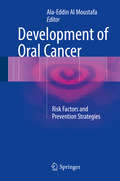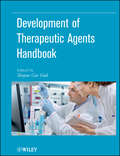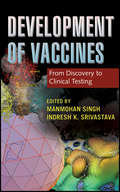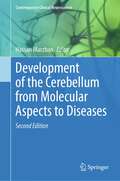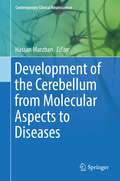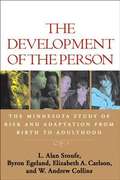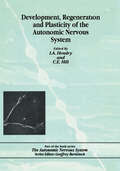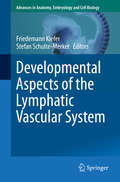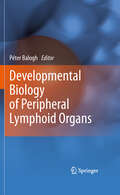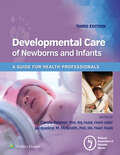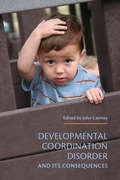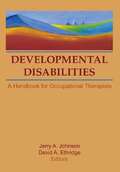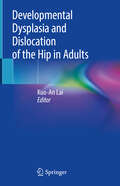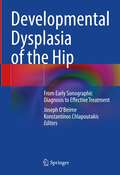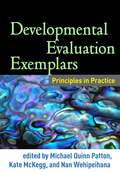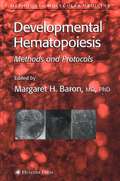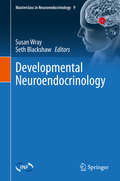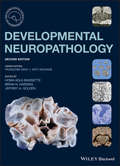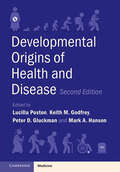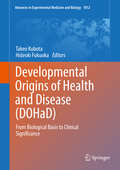- Table View
- List View
Development of Oral Cancer
by Ala-Eddin Al MoustafaThis book aims to provide the reader with a complete understanding of the development of oral cancer by explaining the role of a wide variety of implicated risk factors and identifying their gene targets and key regulators. Some of the discussed risk factors are well known, including smoking, alcohol, betel quid chewing, and oncoviruses such as high-risk human papillomaviruses and Epstein-Barr virus; however, careful attention is also paid to less widely recognized factors, such as Qat chewing and yerba Mate consumption. The book concludes by describing and evaluating the most important strategies currently available for the prevention of oral carcinogenesis in humans. In presenting the most up-todate research and knowledge on these topics, this book will serve as a valuable source of up-to-date information for oncologists, cancer scientists, and medical students.
Development of Shyness and Social Withdrawal
by Kenneth Rubin Robert CoplanWhile both positive and negative peer interactions have long been a focus of scientific interest, much less attention has been given to children who tend to refrain from interacting with peers. This volume brings together leading authorities to review progress in understanding the development, causes, and consequences of shyness and social withdrawal. Compelling topics include The interplay of biological, psychological, family, and interpersonal processes in shyness and social withdrawal from infancy through adolescence. The impact on peer relationships and academic performance. Links among shyness, social withdrawal, and social anxiety disorder. The positive side of unsociability when to 'leave children alone. 'Implications for clinical practice and educational interventions.
Development of Therapeutic Agents Handbook
by Shayne Cox GadA comprehensive look at current drug discovery and development methods--and the roadmap for the futureProviding both understanding and guidance in characterizing potential drugs and their production and synthesis, Development of Therapeutic Agents Handbook gives professionals a basic tool to facilitate research and development within this challenging process. This comprehensive text brings together, in one resource, a compendium of concepts, approaches, methodologies, and limitations that need to be considered in the formulation of therapeutic agents across a range of therapeutic fields. Both a reference and a call to action for the pharmaceutical industry, Development of Therapeutic Agents Handbook examines recent innovations taking shape in the various medical disciplines involved in drug discovery, and shows why these advances need to be embraced universally among researchers to improve their solution strategies. Additional subject matter includes:Extensive coverage and in-depth look into novel treatments and therapeuticsDiscussion of hot topics like new drugs and nutraceuticals, the discovery and development of vaccines, cancer therapeutics, and market overviewsCoverage of therapeutic drug development for specific disease areas, such as cardiology, oncology, breast cancer, and kidney diseasesAs research in biology, chemistry, medicine, and technology rapidly progresses, it is becoming increasingly important for medical researchers to maintain an up-to-date knowledge base of emerging trends directing promising new therapies. Development of Therapeutic Agents Handbook serves this purpose, acting as both a one-stop reference rich in valid science, and a tool to carve out new pathways in the pursuit of bringing safer and more effective drugs to the marketplace.
Development of Vaccines
by Manmohan Singh Indresh K. SrivastavaDevelopment of Vaccines: From Discovery to Clinical Testing outlines the critical steps, and analytical tools and techniques, needed to take a vaccine from discovery through a successful clinical trial. Contributions from leading experts in the critical areas of vaccine expression, purification, formulation, pre-clinical testing and regulatory submissions make this book an authoritative collection of issues, challenges and solutions for progressing a biologic drug formulation from its early stage of discovery into its final clinical testing. A section with details and real-life experiences of toxicology testing and regulatory filing for vaccines is also included.
Development of a New Heterocycle-Forming Reaction and Kinetic Resolution with N-Heterocyclic Carbenes (Springer Theses)
by Yinli WangIn this book, the author focuses on exploring new organocatalytic transformations under operationally simple and environmentally friendly reaction conditions. Two new types of catalytic reactions promoted by N-heterocyclic carbenes (NHCs) are described. The oxa- and azacycle-forming reactions of sulfonylalkynols and sulfonylalkynamides are broadly considered to be a new type of activation mode in NHC chemistry, wherein the bond formation with internal O- and N-nucleophiles occurs at the γ-position of the propargyl sulfones with 1,2-sulfonyl migration. The resulting oxa- and azacycles are core structures in many biologically significant compounds and medicinally important agents. In addition, the book develops the chiral NHC-catalyzed kinetic resolution of α-hydroxy carboxylic acid derivatives based on chiral recognition of the substrate–cocatalyst complex. In this carboxylate cocatalyst-assisted chiral acylation, the reaction rate acceleration and selectivity enhancement are interpreted in terms of the reversible complexation of the substrate and carboxylate cocatalyst, which is verified by control experiments and measured using analytical methods. The findings described here reveal a promising new aspect of not only NHC catalysis but also identifying novel catalysis systems.
Development of the Cerebellum from Molecular Aspects to Diseases (Contemporary Clinical Neuroscience)
by Hassan MarzbanThis updated reference covers diverse aspects of cerebellar development from a full range of viewpoints, including the epidemiology of cerebellar genetic disorders, developmental anatomy, cell biology, genetics, epigenetics, infectious diseases, and mechanisms involved in the regulation of cell fate, while also focusing on information that is relevant to clinicians caring for patients with cerebellar disorders. The chapters are written by experts in the field of cerebellar development, and the chapters cover diseases related to the cerebellum, along with their epidemiology, clinical features, assessment, and management. In addition to updating the content to cover the significant developments in the field since the first edition, the second edition will include new chapters on Non-Coding RNAs and Cerebellar Development, Development of the Fish Cerebellum, the Role of nNOS/NO on Cerebellar Development in Health and Disease, and rehabilitation in cerebellar ataxia. The effect of the COVID-19 on the cerebellum has been included in related chapters. Development of the Cerebellum from Molecular Aspects to Diseases, 2nd edition, is designed to be valuable reference for both neuroscientists and clinicians.
Development of the Cerebellum from Molecular Aspects to Diseases: From Molecular Aspects To Diseases (Contemporary Clinical Neuroscience)
by Hassan MarzbanThe authors present the most current and cutting-edge knowledge regarding the molecular basis of cerebellar development, focusing on information relevant to laboratory scientists and clinicians providing service to patients with cerebellar disorders. Knowledge obtained from advanced neuroimaging techniques that are used during development, and from molecular- and genetic-based studies has provided rapidly-growing evidence that the cerebellum is a brain region that is highly impacted by developmental defects. Cerebellar defects result in significant intellectual and motor function impairment that affects both the patients and their families.
Development of the Person
by Byron Egeland L. Alan SroufeThe definitive work on a groundbreaking study, this essential volume provides a coherent picture of the complexity of development from birth to adulthood. Explicated are both the methodology of the Minnesota study and its far-reaching contributions to understanding how we become who we are. The book marshals a vast body of data on the ways in which individuals' strengths and vulnerabilities are shaped by myriad influences, including early experiences, family and peer relationships throughout childhood and adolescence, variations in child characteristics and abilities, and socioeconomic conditions. Implications for clinical intervention and prevention are also addressed. Rigorously documented and clearly presented, the study's findings elucidate the twists and turns of individual pathways, illustrating as never before the ongoing interplay between developing children and their environments.
Development, Implementation and Evaluation of Curricula in Nursing and Midwifery Education
by Ingrid Darmann-Finck Karin ReiberThis book provides a review of central contributions from a variety of countries, and is intended to enhance and expand the national professional dialogue on curricula in nursing and midwifery education. All questions of a general nature related to the topic of “curricula” are dealt within the framework of this internationally oriented anthology. Though the contributions may address challenges concerning curriculum work in a specific country, they have been selected and structured to ensure their applicability to other countries. The book’s main goals are to highlight the various phases and aspects of curriculum development and to offer a broad international perspective on the topic. It provides an overview of the international status quo of the theory development and seeks to promote an ongoing international discussion and cooperation in curriculum work in nursing and midwifery education. When there are major changes in nursing and midwifery care, nursing (and midwifery) education has to change, too. Curricula offer an important basis for shaping educational processes at vocational schools and universities. The discussion of nursing and midwifery curricula is currently primarily taking place at the national level. The book shows that the approaches and instruments used in the development, construction, implementation and evaluation of curricula in nursing and midwifery education in different countries relate to very similar theoretical foundations. This finding can be seen as a confirmation of the national approaches. Although the book chiefly focuses on nursing education, examples from midwifery education are also included, so as to foster international and interprofessional cooperation.
Development, Regeneration and Plasticity of the Autonomic Nervous System
by I. A. Hendry C. E. HillEach volume in the Autonomic Nervous System series deals with a different area of autonomic control in health and disease. This, the second volume, provides an overview on the nature of the factors that exert constraints on the differentiation and maturation of the autonomic nervous system. Subjects covered include: development of autonomic neurones; molecules affecting nerve growth and survival; regeneration after injury; and the degree to which the wiring of the nervous system is rigid or fixed.
Developmental Aspects of the Lymphatic Vascular System
by Friedemann Kiefer Stefan Schulte-MerkerThe book focuses on the lymphatic vascular system from a developmental biologist's point of view. It provides an overview on the many recent advances in understanding the development of lymphatic vessels, using advanced genetic models in conjunction with state of the art imaging. For each chapter a synopsis is provided, highlighting the main points in a concise manner. The book is intended for professors and researchers in vascular biology, angiogenesis research and developmental biology. It furthermore offers an excellent basis for entry level researchers and newcomers to this field, as well as for teachers, graduate students, advanced science and medical students.
Developmental Biology and Cancer
by Gisele M. Hodges Charles RowlattThis book addresses possible analogies between cancer and developmental biology. An international group of experts provides a multidisciplinary approach, allowing biological or clinical scientists involved with cancer research to integrate specific information from diverse areas.Five concepts of cancer are presented, and developmental biology is reviewed at five levels. These are integrated in discussions of failure in organisation as a basis of cancer and its control. The book will be a valuable reference for both newcomers as well as experienced biological and clinical scientists.
Developmental Biology of Peripheral Lymphoid Organs
by Peter BaloghThe human immune system is a complex network of tissues and organs dispersed throughout the body. Immunology, as one of the most rapidly evolving fields in bio¬medical research, has to date covered the essential cellular and molecular events neces¬sary for immune responses to occur. However, it has paid relatively little attention to important developmental processes underlying the formation of the tissues themselves that carry out immune responses in humans and other mammalians. In contrast to the thymus and bone marrow that are the sole tissues for generating mature leukocytes for antigen recognition and han¬dling in humans and most mammalian species, the peripheral lymphoid tissues where adaptive immune responses are focused display broad tissue distribution and possess diverse archi¬tectural characteristics. These organs develop prior to the individual's exposure to external antigens, and despite their similar functions, their varied appearances indicate a substantial complexity of tissue ontogeny. This volume presents a comprehensive overview of the developmental features of the major peripheral lymphoid organs, thus examining the connection between immunological functionality and structural characteristics utilizing a developmental approach, for an audience ranging from undergraduate students to senior researchers in immunology, histology and clinical medicine.
Developmental Care of Newborns & Infants
by NannOffers evidence-based guidelines for interdisciplinary, developmentally supportive caregiving for infants and their families, beginning with prenatal planning and continuing through the delivery room and neonatal intensive care unit experiences, the transition to home, and the time following discharge. Provides a foundation for best practices and services as a cornerstone for NICU health professionals’ education and clinical practice.
Developmental Coordination Disorder and its Consequences
by John CairneyDevelopmental Coordination Disorder (DCD) is a neuro-developmental disorder that affects one in every twenty children. Children with DCD have problems with motor coordination that make everyday tasks such as active play, writing, eating, and dressing difficult and frustrating. Despite how common this health condition is, DCD is often misunderstood and frequently goes undiagnosed. In Developmental Coordination Disorder and its Consequences, international experts on DCD from several disciplines present the latest evidence on the diagnosis, consequences, and neuropsychological underpinnings of the disorder. With chapters covering consequences related to mental health, social functioning, and physical health and activity, this collection is the most comprehensive volume to cover the health and social consequences of DCD in children. Clearly written, it will be of interest to parents, teachers, and physicians interested in this disorder.
Developmental Disabilities: A Handbook for Occupational Therapists
by Jerry A Johnson David A EthridgeThis significant volume provides broad coverage of the spectrum of problems confronted by patients with developmental disabilities and the many kinds of occupational therapy services these individuals need. Experts identify exemplary institutional and community service programs for treating patients with autism, cerebral palsy, epilepsy, and mental retardation. A welcome contribution to the meager professional literature on the subject, Developmental Disabilities: A Handbook for Occupational Therapists will be an enormously helpful resource for therapists who work with both children and adults, ranging from mild to severe levels of impairment. You will learn how to establish a therapeutic environment for children with autism, develop a pre-vocational program in a pediatric skilled care facility, use qualitative research to obtain insight into the world of adults with significantly limiting cerebral palsy, and provide early intervention for your developmentally disabled patients.
Developmental Drama
by Mary BookerPeople living with severe or profound multiple disabilities (PMLD) can often struggle to connect with the world around them. This book shows how, through enjoying dramatic interaction, they can develop their communication skills, learn to deal with emotions more effectively and gain a greater understanding of their physical and social environment. This guide presents a variety of ways in which drama can be used as a medium for assisting the social and emotional development of people with PMLD, including sensory impairment. It fully explains techniques that are proven to build confidence and promote participation, and illustrates how to include support staff effectively within the process. Charting the author's own journey as a dramatherapist, it clarifies in detail some effective approaches and how to address key issues that arise in dramatherapy practice. This is an accessible and life-saving guide for practitioners looking to use drama in work with people with PMLD, but are unsure where to begin.
Developmental Dysplasia and Dislocation of the Hip in Adults
by Kuo-An LaiThis book provides descriptions of up-to-date treatment options for adult DDH/CDH (Dysplasia and Dislocation of the Hip/Congenital Dislocation of the Hip). It describes the author’s modification of peri-acetabular osteotomy for young adult DDH patients, resurfacing arthroplasty for selected patients and total hip arthroplasty for advanced arthritis and dislocation. Untreated high dislocation of the hip in adults are rare in developed countries now. The chapter of total hip describes more than 300 total hips for high dislocation with specific attempt to symmetrize the lower limbs. Techniques are described in detail, which includes ilio-femoral distraction, acetabular reconstruction, femoral osteoplasty, and shortening, derotation and corrective osteotomies. The editors invited several surgeons who are reputed for treating adult DDH with joint salvage and joint replacement to write chapters of this book.
Developmental Dysplasia of the Hip: From Early Sonographic Diagnosis to Effective Treatment
by Joseph O’Beirne Konstantinos ChlapoutakisThis book is a reference source containing all the relevant information about Developmental Dysplasia of the Hip (DDH), for people who practice or utilize hip sonography for the early detection and treatment of DDH. It aims at improving the population screening for DDH, thus contributing to the elimination of the disorder and its devastating consequences. What makes this book different from existing literature is the fact that, apart from the (updated) information about the disorder (including development, pathophysiology, etiology, pathogenesis, risk factors etc.) and a short technical guidance, the reader will find all relevant knowledge to organize training and set up screening. This includes analysis of the rationale behind universal sonographic screening, a comparative presentation of the sonographic techniques, teaching course structure / management and setting up a screening service, including audit, quality control of the scans etc. Special chapters about radiological diagnosis, imaging the consequences of non-diagnosis or maltreatment of the disorder, clinical management of DDH cases and shaping the future of hip sonography, are also provided. The book will be of interest to any medical doctor, but in particular to those working in the fields of radiology, pediatrics, orthopedics or general medicine, sonographers performing hip scans, or specialist nurses dealing with DDH.
Developmental Evaluation Exemplars
by Michael Quinn Patton Nan Wehipeihana Kate MckeggResponding to evaluator and instructor demand, this book presents a diverse set of high-quality developmental evaluation (DE) case studies. Twelve insightful exemplars illustrate how DE is used to evaluate innovative initiatives in complex, dynamic environments, including a range of fields and international settings. Written by leading practitioners, chapters offer a rare window into what it takes to do DE, what roles must be fulfilled, and what results can be expected. Each case opens with an incisive introduction by the editors. The book also addresses frequently asked questions about DE, synthesizes key themes and lessons learned from the exemplars, and identifies eight essential principles of DE. See also Michael Quinn Patton's Developmental Evaluation, the authoritative presentation of DE.
Developmental Hematopoiesis
by Margaret H. BaronThe first collection of methods to study embryonic and fetal hematopoiesis in both invertebrate (fruit flies) and vertebrate (frog, fish, mouse, chick, and human) organisms. These state-of-the-art techniques range from the genetic, molecular, and cellular, to cell and embryo explant culture and whole animals, including in vivo imaging. Bioinformatic and functional genomic approaches for studying stem cells and their supportive stromal cells are also discussed. The protocols follow the successful Methods in Molecular MedicineTM series format, each one offering step-by-step laboratory instructions, an introduction outlining the principle behind the technique, lists of the necessary equipment and reagents, and tips on troubleshooting and avoiding known pitfalls.
Developmental Neuroendocrinology (Masterclass in Neuroendocrinology #9)
by Susan Wray Seth BlackshawIn this book, experts in the field discuss the latest research in developmental neuroendocrinology. Given that the hypothalamus is the center of neuroendocrine activity, the reader will learn about the molecular specification of hypothalamic cells, developmental modulators and epigenetic factors influencing hypothalamic development, and the development of neuroendocrine circuits. Each chapter provides a concise review of the current and future perspectives in developmental neuroendocrinology. Important insights into state-of-the-art techniques applied to functional circuit tracking, lineage tracing of hypothalamic cells, and the identification of genes altered through epigenetic mechanisms are also provided. Given its scope, the book will appeal to all students and researchers who are eager to understand the processes involved in hypothalamus development and the establishment of neuroendocrine circuits. This is the ninth volume in the International Neuroendocrine Federation (INF) Masterclass in Neuroendocrinology series* that aims to illustrate highest standards and encourage the use of the latest technologies in basic and clinical research and hopes to provide inspiration for further exploration into the exciting field of neuroendocrinology. *Volumes 1-7 published by Wiley.
Developmental Neuropathology
by Homa Adle-Biassette Brian N. Harding Jeffrey A. GoldenA definitive, clinically oriented guide to the pathology of genetics of developmental neuropathology Developmental neuropathology relates to the wide range of disorders affecting the developing brain or pre- and post-natal life, with emphasis on the genetic and molecular mechanisms involved. This book provides a practical guide to diagnosing and understanding these disorders affecting this vulnerable population and potentially stimulates further advances in this exciting area. It also addresses the controversies in inflicted head injury in infants. The fourth major title to be approved by the International Society of Neuropathology (ISN), Developmental Neuropathology offers in-depth chapter coverage of brain development; chromosomal changes; malformations; secondary malformations and destructive pathologies; developmental vascular disorders; acquired metabolic and exogenous toxins; metabolic disorders; Rett syndrome and autism; and infectious diseases. The text provides: Clinical, disease-oriented approach to the pathology and genetics developmental neuropathology Fuses classical and contemporary investigative approaches Includes genetic and molecular biological pathogeneses Fully illustrated Approved and endorsed by International Society of Neuropathology Developmental Neuropathology is the perfect book for practicing neuropathologists, pediatric pathologists, general pathologists, neurologists, and geneticists in deciphering the pathology and pathogenesis of these complex disorders affecting the nervous system of the embryo, fetus, and child.
Developmental Origins of Health and Disease
by Lucilla PostonThe concept of the early life developmental origins of health and disease (DOHaD) in adults has stimulated a new approach to understanding disease trajectories, with major public health implications. Indeed, the principle of the 'lifecourse of disease' now influences health policies internationally. Environmental influences during pregnancy and early life that affect lifelong health are well documented, but there is a new focus on the preconception period and the significance of paternal health on the fetus. This fully revised second edition highlights scientific and clinical advances in the field, exploring new understanding of mechanisms such as epigenetics and the increasingly recognised role of external influences, including pollution. The book is structured logically, covering environment, clinical outcomes, mechanisms of DOHaD, interventions throughout the lifespan and finally implications for public health and policy. Clinicians and scientists alike will improve their understanding of the developmental origins of health and disease with this essential text.
Developmental Origins of Health and Disease: From Biological Basis to Clinical Significance (Advances in Experimental Medicine and Biology #1012)
by Takeo Kubota Hideoki FukuokaThis book addresses the developmental origins of health and disease (DOHaD), a new medical concept that demonstrates that various adult diseases start in the fetal period. It discusses our current understanding of the molecular mechanisms of DOHaD, including gene body epigenetics and non-coding RNA, and comprehensively examines diseases such type 2 diabetes, a well known as standard DOHaD-associated disease, as well as non-alcoholic fatty liver disease, hypertension and neurodevelopmental disorders. It argues that most adult diseases start at a very early stage, such as in the fetal and neonatal periods, and that earlier prevention and intervention would result in better outcomes for adult diseases such as type 2 diabetes and cardiac disorders, which are increasing in both developed and developing countries. The book appeals to obstetricians and pediatricians, as well as physicians who treat adult patients, wanting to understand the origins of diseases.
